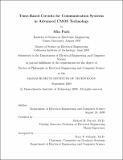| dc.contributor.advisor | Michael H. Perrott. | en_US |
| dc.contributor.author | Park, Min, Ph. D. Massachusetts Institute of Technology | en_US |
| dc.contributor.other | Massachusetts Institute of Technology. Dept. of Electrical Engineering and Computer Science. | en_US |
| dc.date.accessioned | 2010-04-26T19:40:53Z | |
| dc.date.available | 2010-04-26T19:40:53Z | |
| dc.date.copyright | 2009 | en_US |
| dc.date.issued | 2009 | en_US |
| dc.identifier.uri | http://hdl.handle.net/1721.1/54229 | |
| dc.description | Thesis (Ph. D.)--Massachusetts Institute of Technology, Dept. of Electrical Engineering and Computer Science, 2009. | en_US |
| dc.description | This electronic version was submitted by the student author. The certified thesis is available in the Institute Archives and Special Collections. | en_US |
| dc.description | Cataloged from student submitted PDF version of thesis. | en_US |
| dc.description | Includes bibliographical references (p. 145-151). | en_US |
| dc.description.abstract | As device size scales down, there have been challenges to design conventional analog circuits, such as low voltage headroom and the low intrinsic gain of a device. Although ever-decreasing device channel length in CMOS technology has mainly negative effects on analog circuits, it increases device speed and reduces the power consumption of digital circuits. As a result, time-based signal processing has been attracting attention because time-based circuits take advantage of high speed and low power devices to deal with analog information in the time domain. In this thesis, we focus on a ring oscillator as a core time-based circuit for communication systems. Ring oscillators are employed in analog-to-time conversion or time-to-digital conversion. In this work, we present A/D converters and an RF modulator based on ring oscillators in deep sub-micron CMOS processes. We introduce a VCO-based [sigma][delta] A/D converter utilizing a voltage-controlled ring oscillator (ring VCO) as a continuous-time integrator. We propose to replace conventional integrators designed with analog circuits in a [sigma][delta] modulator with a ring VCO and a phase detector, thereby implementing an A/D converter without traditional analog circuits. We also propose a single-slope A/D converter using time-to-digital conversion. By combining a few analog circuits and a ring oscillator based Time-to-Digital Converter (TDC), we achieve highly digital A/D conversion. Finally, we demonstrate a VCO-based RF modulator. The proposed RF modulator generates an RF signal by simply switching transistors. As opposed to an RFDAC approach, the proposed RF modulator is not limited by quantization noise because it employs multiphase PWM signals. A VCO-based OP amp is also introduced as an alternative method of designing an OP amp in deep sub-micron CMOS. The proposed VCO-based OP amp is utilized to generate the multiphase PWM signals in the RF modulator. This thesis also presents the fundamental limitations of a ring oscillator as a timebased circuit. Although the idea of time-based signal processing employing a ring oscillator has its own limitations such as non-linear tuning characteristics and phase noise, the basic idea is worth investigating to solve the serious problems of analog circuits for future CMOS technology. | en_US |
| dc.description.statementofresponsibility | by Min Park. | en_US |
| dc.format.extent | 151 p. | en_US |
| dc.language.iso | eng | en_US |
| dc.publisher | Massachusetts Institute of Technology | en_US |
| dc.rights | M.I.T. theses are protected by
copyright. They may be viewed from this source for any purpose, but
reproduction or distribution in any format is prohibited without written
permission. See provided URL for inquiries about permission. | en_US |
| dc.rights.uri | http://dspace.mit.edu/handle/1721.1/7582 | en_US |
| dc.subject | Electrical Engineering and Computer Science. | en_US |
| dc.title | Time-based circuits for communication systems in advanced CMOS technology | en_US |
| dc.type | Thesis | en_US |
| dc.description.degree | Ph.D. | en_US |
| dc.contributor.department | Massachusetts Institute of Technology. Department of Electrical Engineering and Computer Science | |
| dc.identifier.oclc | 603582671 | en_US |
